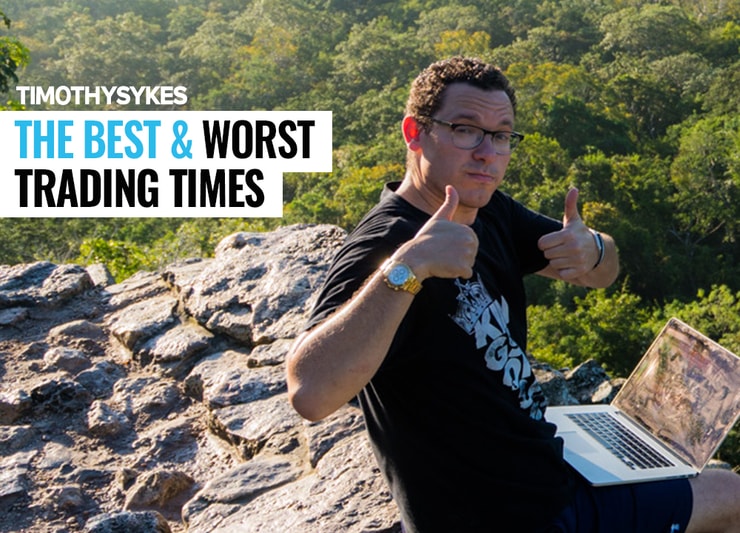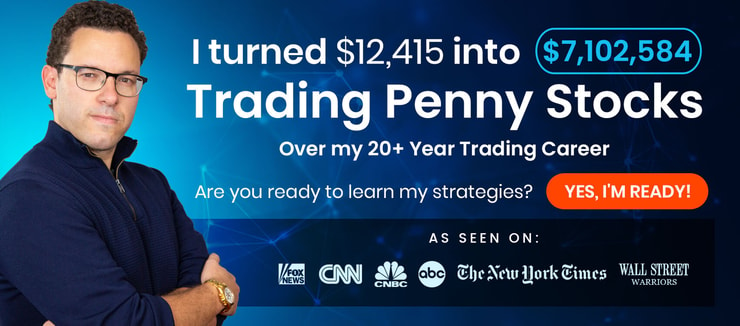The question of what are the best and worst trading times comes up over and over again. If only it was as easy as “only trade from 9:30–11:00 a.m., except on Fridays…”
The reality is, there’s a lot more to it than that. It’s not an exact science. I do have preferred trading times … but it’s a disservice to limit the discussion to specific hours. In the Trading Challenge, I teach all the nuances I’ve learned in two decades of trading and a decade of teaching.
Read on because this post outlines my thoughts on the best trading times. Also, later in this post, there’s a video with two different points of view about the best trading times. (And a bit of fun with Tim Bohen about his desire to hunt and eat animals.)
Before we get to that, there are some things to consider…
Table of Contents
Does the Time of Day Matter for Trading?
Yes, the time of day matters, but it’s not the be-all and end-all. One thing you must consider is what works best for you. Your personal schedule. It’s so important, I’ve made it one of the seven indicators of the Sykes Sliding Scale (S3) from my Trader Checklist guide. Read on for more about the S3…
Take A Step Back To Find the Best Times to Trade
As you go through the testing process, you want to figure out your sweet spot. But to do that, you have to take a step back and review every trade. It takes time — like a few years or more. I’d say for most traders it’s more because anything less and you’re still a newbie.
Think about it, if you take up any serious discipline, it takes years to hone your skills. Ask any professional athlete or musician. They don’t think they have it all figured out in less than a year. Trading is no different. And don’t let any of those fake ‘gurus’ talk you into anything different. Ask them to show you the details of every trade before you buy their snake oil.
What should you look for? If you keep a trading journal — which I recommend — then make the time of day one of the criteria you track. It’s much easier to be objective about it that way. All my top students tested and tracked various setups until they figured out what works for them.
I hear it over and over again when I interview top students…
“I took a look at my stats and realized this was the best setup for me and this other setup was bad.”
More Breaking News
- Is Rigetti’s Quiet Storm Brewing?
- American Airlines Stock: Rise or Retreat?
- Stellantis Shares Plummet: Buying Opportunity?
Personal Schedule
Why is your personal schedule so important? Because you don’t want to be distracted when you trade. You need to be 100% focused. It’s too easy to make costly mistakes if you’re not focused.
Remember, it’s not an exact science. I can’t say, “You should trade the first 90 minutes after the open and the last hour before the markets close.” That’s ridiculous.
S3: At What Time and Your Personal Schedule
This is one of the seven indicators on the Sykes Sliding Scale. The S3 is my tool to quickly evaluate a trade ahead of time. It’s covered in depth in my Trader Checklist guide. It kills me that so few traders take the time to study the guide and use what it teaches.
The seven indicators aren’t equal. Three of the seven have a max value of 20 points each. The other four have a max value of 10 points each. Therefore, the highest possible score is 100. Check this out…
… at what time and your personal schedule is one of the three more heavily weighted indicators. So don’t overlook it. If you’ve gotta walk out the door in 10 minutes … it’s unlikely you want to enter a trade. That’s not to say you couldn’t achieve your goals in 10 minutes. It’s just very risky to expect it to happen.
Sometimes the Best Trade Is No Trade
This brings up one of the most important concepts I’ve been trying to pound into students’ heads for years…
Sometimes the best trade is no trade. Start with that underlying concept before you try to figure out what the best trading times are. Be willing to walk away — completely.
I’ll come back to the best times to trade. But let’s start with…
The Worst Times to Trade
When There Are No Plays
This should be obvious, but I can’t tell you how often I get messages from newbies saying they just want to trade. Today. To “get their feet wet.” Then they lose a lot of money.
The sad thing is, sometimes they don’t learn. They keep getting into trades with no clear reason and no plan. This is the typical degenerate gambler mentality. Don’t get sucked into that trap.
Wait for the plays to come to you.
Revenge Trading
Don’t try to make up for a big loss by taking another trade. I see it over and over again. I’ve even fallen for this myself. It’s not worth it. Most traders do it at some point. The key is to recognize it and learn to avoid it.
If you catch yourself trading the same stock saying “I’m gonna at least get back to zero on this one,” that’s a bad sign. Or, “That trade screwed up my weekly profit/loss… I need a winning trade to get back up…” That’s also a bad sign. See rule #47 here.
Chasing Action
If you feel like you need some action … that’s a terrible time to trade. That’s also degenerate gambler mentality. Walk away. Start to think like a retired trader. Only come out of retirement when the setup is so good you’d be stupid not to trade it.
(That’s not to say you’re gonna win just because the setup is right. If it was only that easy. To learn all the nuances, apply for the Trading Challenge now.)
When You Have Other Commitments
This is related to your personal schedule.
Look, I think you should be the best you can be at everything you do. Whether it’s trading, your relationships, hobbies … whatever. Be the best you can be.
It’s nearly impossible to be a great trader if you’re focused on something else. Likewise, it’s nearly impossible to focus on a conversation if you’re in the middle of a trade.
(Yes, swing traders do things a little different. Still, I wonder how many of them can detach when they have a large open position? I find it very difficult. If you can, more power to you.)
Illness
I sometimes trade when I’m feeling ill. But my stats show that I don’t trade as well. If you’re sick, why not rest? It’s OK to have a sick day as a trader. It’s much better than taking a big loss because you think you need to trade.
Dudes on Ludes Shouldn’t Trade
There’s a twisted undercurrent of coke heads and other drug abusers in the trading world. From Wall Street to the offshore pumpers, it’s there. I’m not saying everyone does it. But I do want to warn you against it. I assure you it doesn’t give you an edge.
Heck, I can barely take over-the-counter cold medication without feeling weird. So I try to avoid it.
Hungover
Look, I’m not saying I haven’t done this. I’m human and trading isn’t like the Olympics. So learn from my experience. Trading while hungover is not the best idea. Your brain is cloudy. Your judgment is skewed. Go hydrate, instead. Then avoid overdoing it when markets are open the next day.
Now, that said, the key to trading when things aren’t perfect is preparation. I’ve traded from planes, trains, cruise ships, and cars. I was on a train once where the WiFi dropped as we went downhill and only came back again at the top of the next hill.
Trading doesn’t have to be the perfect controlled environment. But the key is preparation. If you’re prepared it’s possible to overcome obstacles. If not … you could pay a big price.
Alright, those are some of the worst times to trade in terms of your personal schedule. Now for the best trading times…
The Best Times to Trade

2025 Millionaire Media, LLCThis list of best trading times closely follows my Trader Checklist guide.
Wait, you want actual times of day, right? Keep reading, I’ll get there. I just don’t want you to think this is an exact science. It’s not.
When the Pattern/Price Action Is Clear
Again, this seems obvious. But I see newbies try to impose their will on a stock’s price action or imagine they see a pattern that’s just not there. And … this is very important … it’s not only about the price action or pattern. Yes, it’s one of the three more heavily weighted S3 indicators. But it’s still only one of seven indicators.
So look for patterns and price action. But also use the other indicators.
When the Risk vs. Reward Is in Your Favor
If you don’t know your risk versus reward … or it isn’t reasonably in your favor … don’t trade. Trade with clearly defined risk. And know your potential reward so you can exit when you’ve met your goals or if the trade turns against you. Anything less is almost worse than a degenerate gambler. You’ve been warned.
When the Stock Is Liquid
I try to avoid illiquid stocks. I learned my lesson the hard way on my worst ever loss. I was, essentially, stuck in a position and took a big loss. So focus on trading when a stock has enough volume to get in and out. You still might have slippage, but at least you won’t be completely stuck.
When the Time of Day Is Good for the Pattern You’re Trading
Now we get a little more into the actual time of day. But be prepared to adapt because markets shift.
Have you noticed some of my pattern names include a time of day? I love morning panic dip buys. It’s my favorite pattern recently. That’s not to say I never dip buy other times of the day. But I particularly like the morning panic dip buys. It’s easier for me to anticipate what might happen.
Also, I don’t like to chase. There were a few weeks earlier this year when the panics were a little later. They were coming in the late morning and even into early afternoon. I attempted to adapt, but I didn’t chase. Nor should you. If the setup you like is happening but the time of day has shifted, test with small positions until you figure it out. Better yet, paper trade it.
That said, the morning panics I prefer shifted back closer to the market open. It was sort of a short-term anomaly. The lesson: be willing to adapt to changing markets.
When the Reason or Catalyst Is Strong
Learn to observe how the market reacts to news. Also, try to determine if the news is already built into the price. I prefer to trade a stock when there’s a clear catalyst.
Does that mean I never trade a stock with no news? No. But when a stock comes up on StocksToTrade’s biggest percent gain scan, I search for news on it. I want to know what’s driving price action before I risk my hard-earned money. If there’s no news, I’m even more conservative.
When the Market Environment Is Suitable
A lot of newbies overlook this. If you’ve read my recent posts you know I’ve commented on the current market environment. Especially the trade war and how it’s creating uncertainty. As a trader, you have to be aware of the overall markets.
When you aren’t worried about a tweet causing a sudden drop in the S&P 500 … it can be much easier to trade. But if you don’t know when the next tweet or piece of news might tank the market … be more conservative.
Video: When Is the Best Time To Trade
Check out the video I made with Tim Bohen. In under seven minutes, you’ll learn…
- Why I love to trade the market open (but Bohen doesn’t).
- The pros and cons of market open and power hour trading.
- Why Bohen thinks ‘deer in the headlights’ is a bad way to trade…
- When it pays to buy near the market open. (And what you must understand about trading the open to protect yourself.)
- PLUS: a little fun between me and Tim. (He tried to get away with using one of my favorite sayings but I called him out…)
Trading Times Market Wrap
My goal is to help you become a self-sufficient trader. That way you have skills for life. When it comes to the best times to trade, like everything else in trading, it’s not an exact science.
I hope this post gives you some things to consider as you build your knowledge account. Now take what you’ve learned and start testing. Even if you’re not trading yet, you can paper trade and get a feel for how stocks move at different times. Keep a trading journal as you practice — it can potentially pay dividends in the future.
Do you have favorite trading times? Comment below and share your experience with other readers. New to trading? What time fits best with your personal schedule? Comment below, I love to hear from all my readers!











Leave a reply